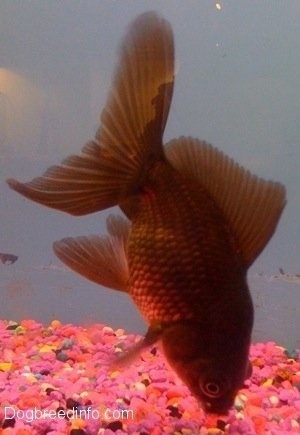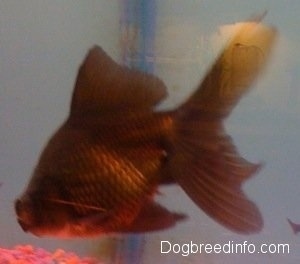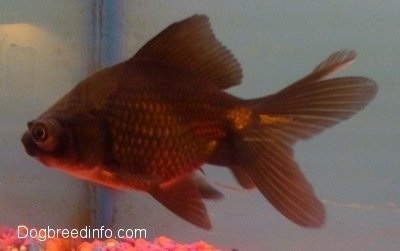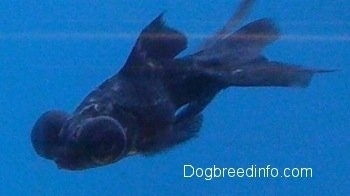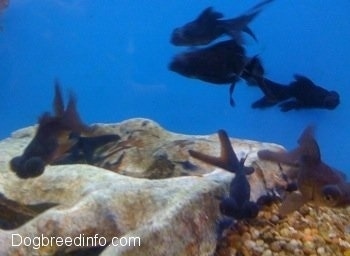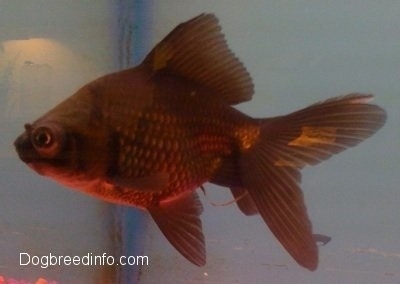
Carassius auratus
Cyprinids
Cyprinidae
Cyprininae
Fancy Goldfish
10 gallons, larger is better
Mid-dweller, but does visit all levels.
Easy, suitable for beginners.
Peaceful schooling fish. Messy, produce a lot of waste. Should have some type of extra aeration, as they have high oxygen requirements. Make great bottom scavengers. May up-root plants.
Get along well with other non-aggressive fish. Do best with other goldfish, but can live with other peaceful fish species. Goldfish put off a lot of ammonia. While goldfish can handle a higher level of ammonia, this level can kill other types of fish and must be taken out of the water. If you are going to keep goldfish with other fish species, be sure to monitor your ammonia levels. Goldfish do not like ammonia and prefer a clean, filtered tank. Great social, community fish, however, since they prefer colder temperatures, they do best with other goldfish that can also live in these cooler temps.
25 years
4 inches (10 cm)
Like to eat live plants, so fake plants are ideal if you do not want your plants eaten. Gentle circulation. Do not put any sharp plastic plants or decor into the tank or they may damage their eyes. The eyes may even fall off, causing them to go blind.
Freshwater
6.0 to 8.0
dH: 5 - 19 (soft to hard)
Considered a cold-water fish. Ideally they like 50° - 70° F (10° - 21° C). A goldfish can live in waters just above freezing. There are many goldfish that live in outside ponds, and so long as the water does not freeze, they can survive the winter. However because of the black moor's poor eyesight, they do not always do well in outside ponds. They do not particularly like tropical temperatures, and will not be as healthy, but they can survive.
Omnivore, meaning they will eat both meat and vegetables. Flake foods (green flakes). Does best on a special goldfish diet, which can be purchased at your local pet store. They do not tolerate tropical fish food very well, as they do not have stomachs. Their food is absorbed as it travels through their intestines. Goldfish food has a higher alkaline content than tropical fish food. Feed flake foods every day and give brine shrimp (either live or frozen), tubifex worms, blood worms and daphnia only as a treat. Freeze-dried foods are recommended over live foods to avoid introducing bacteria and parasites into the tank. Because of their eyes, they will have a harder time finding certain foods that float around before they settle down to the bottom of the tank. Watch that other faster fish are not eating all of the food before they get any. Do best with other fish that also have a hard time seeing, so they get an equal chance to eat their food. Sinking food is best.
During the breeding season males develop white pimple-like bumps called breeding tubercles on their gill covers and on the leading edge of the pectoral fins. These are used for stimulating the female to release her eggs. Pregnant females develop a deeper body when they are full of eggs (roe), and they also have a larger vent, located right before the anal fin.
Egg layer
China
The black moor goldfish is the black variety of the telescope goldfish. Their eyes are less protruding than the telescope. Can live in very cold temperatures, making them ideal for outdoor ponds. Care must be taken with their protruding eyes so they do not get damaged. Be careful what types of decor you add into the tank so their eyes do not get scratched on a plastic plant with pointy leaves. Start out as a velvety black and may turn somewhat gray as they get older. All of the fancy goldfish variations, such as the black moor, veil-tails, bubble-eyes, orandas, etc., are strains developed through selective breeding, and do not occur in that form naturally.



